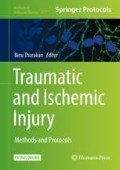Abstract
Traumatic brain injury (TBI) is a significant problem causing high mortality globally. Methods to increase possibilities for treatment and prevention of secondary injuries resulting from the initial physical insult are thus much needed. TBI affects the central nervous system (CNS) and the neurovascular unit as a whole in numerous ways but one of the primarily compromised components is the blood–brain barrier (BBB).
In this chapter, we present a detailed procedure on how stretch injury and oxygen–glucose deprivation (OGD) are applied to brain microvascular endothelial cells of the BBB in order to replicate the actual impact they receive during TBI.
Access this chapter
Tax calculation will be finalised at checkout
Purchases are for personal use only
References
Morrison B III, Elkin BS, Dolle JP, Yarmush ML (2011) In vitro models of traumatic brain injury. Annu Rev Biomed Eng 13:91–126
Morrison B III, Saatman KE, Meaney DF, McIntosh TK (1998) In vitro central nervous system models of mechanically induced trauma a review. J Neurotrauma 15:911–928
Ellis EF, Mckinney JS, Willoughby KA, Liang S, Povlishock JT (1995) A new model for rapid stretch-induced injury of cells in culture - characterization of the model using astrocytes. J Neurotrauma 12:325–339
Berrout J, Jin M, O’Neil RG (2012) Critical role of TRPP2 and TRPC1 channels in stretch-induced injury of blood-brain barrier endothelial cells. Brain Res 1436:1–12
McKinney JS, Willoughby KA, Liang S, Ellis EF (1996) Stretch-induced injury of cultured neuronal, glial and endothelia cells (Effect of polyethylene glycol-conjugated superoxide dismutase). Stroke 27:934–940
Wanner IB, Deik A, Torres M, Rosendahl A, Neary JT, Lemmon VP, Bixby JL (2008) A new in vitro model of the glial scar inhibits axon growth. Glia 56(15):1691–1709
Webster GD, Rzigalinski BA, Gabler HC (2008) Development of an improved injury device for neural cell cultures. Biomed Sci Instrum 44:483–488
Salvador E, Neuhaus W, Foerster C (2013) Stretch in brain microvascular endothelial cells (cEND) as an in vitro traumatic brain injury model of the blood brain barrier. J Vis Exp 80
Burek M, Salvador E, Forster CY (2012) Generation of an immortalized murine brain microvascular endothelial cell line as an in vitro blood brain barrier model. J Vis Exp 66
Forster C, Silwedel C, Golenhofen N, Burek M, Kietz S, Mankertz J, Drenckhahn D (2005) Occludin as direct target for glucocorticoid-induced improvement of blood-brain barrier properties in a murine in vitro system. J Physiol Lond 565:475–486
Abbruscato TJ, Davis TP (1999) Combination of hypoxia/aglycemia compromises in vitro blood-brain barrier integrity. J Pharmacol Exp Ther 289:668–675
Kleinschnitz CBK, Kahles T, Schwarz T, Kraft P, Göbel K, Meuth SG, Burek M, Thum T, Stoll G, Förster C (2011) Glucocorticoid insensitivity at the hypoxic blood–brain barrier can be reversed by inhibition of the proteasome. Stroke 42:1081–1089
Dembinski TC, Leung CKH, Shiu RPC (1985) Evidence for a novel pituitary factor that potentiates the mitogenic effect of estrogen in human-breast cancer-cells. Cancer Res 45:3083–3089
Author information
Authors and Affiliations
Corresponding author
Editor information
Editors and Affiliations
Rights and permissions
Copyright information
© 2018 Springer Science+Business Media, LLC
About this protocol
Cite this protocol
Salvador, E., Burek, M., Förster, C.Y. (2018). An In Vitro Model of Traumatic Brain Injury. In: Tharakan, B. (eds) Traumatic and Ischemic Injury. Methods in Molecular Biology, vol 1717. Humana Press, New York, NY. https://doi.org/10.1007/978-1-4939-7526-6_17
Download citation
DOI: https://doi.org/10.1007/978-1-4939-7526-6_17
Published:
Publisher Name: Humana Press, New York, NY
Print ISBN: 978-1-4939-7524-2
Online ISBN: 978-1-4939-7526-6
eBook Packages: Springer Protocols

